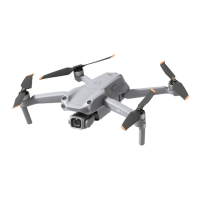6
©
2021 DJI All Rights Reserved.
Product Prole
Introduction
DJI Air 2S features a fully stabilized 3-axis gimbal and 1-inch CMOS sensor camera that can shoot
5.4K 30fps, 4K 60fps, and 1080p 120fps video as well as 20MP photos. Capture complex shots easily
with DJI signature technologies such as Obstacle Sensing and Advanced Pilot Assistance System 4.0
and enjoy Intelligent Flight modes such as MasterShots, Hyperlapse, QuickShots, and FocusTrack
which includes ActiveTrack 4.0, Spotlight 2.0, and Point of Interest 3.0. DJI Air 2S features both an
Infrared Sensing System and Forward, Backward, Upward, and Downward Vision Systems, allowing for
hovering and ying indoors as well as outdoors and for automatic Return to Home. The aircraft has a
maximum ight speed of 42 mph (68.4 kph) and a maximum ight time of 31 minutes.
DJI Air 2S comes equipped with the DJI RC-N1 remote controller which boasts four built-in antennas
and DJI’s long-range transmission O3 (OCUSYNC
TM
3.0) technology, oering a maximum transmission
range of 7.5 mi (12 km) and video quality of up to 1080p from the aircraft to the DJI Fly app on a mobile
device. The remote controller works at both 2.4 and 5.8 GHz, and is capable of selecting the best
transmission channel automatically without latency. The aircraft and camera can easily be controlled
using the onboard buttons. The maximum runtime of the remote controller is six hours.
Preparing the Aircraft
All aircraft arms are folded before the aircraft is packaged. Follow the steps below to unfold the aircraft.
1. Remove the gimbal protector from the camera.
2. Unfold the front arms, and then unfold the rear arms.
Attach the gimbal protector when not in use.
Maximum ight time was tested in an environment with no wind while ying at a consistent 12 mph
(19.4 kph) and the maximum ight speed was tested at sea level altitude with no wind. These
values are for reference only.
The remote controller reaches its maximum transmission distance (FCC) in a wide-open area
with no electromagnetic interference at an altitude of about 400 ft (120 m). The maximum
transmission distance refers to the maximum distance that the aircraft can still send and receive
transmissions. It does not refer to the maximum distance the aircraft can y in a single ight.
The maximum runtime was tested in a laboratory environment and without charging the mobile
device. This value is for reference only.
5.8 GHz is not supported in some regions. Observe the local laws and regulations.
3. Attach the propellers with marks to the motors with marks. Press the propeller down onto the
motors and turn until it is secure. Attach the other propellers to the unmarked motors. Unfold all the
propeller blades.

